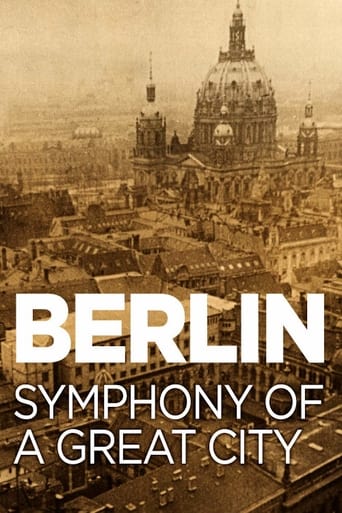Horst in Translation ([email protected])
"Berlin: Die Sinfonie der Grosstadt" or "Berlin: Symphony of a Great City" is not only evidence of the fact that "Großstadt" was once written with 2 s, but it is also a black-and-white silent film documentary about Germany's capital. This one is from almost 90 years ago, so it includes recordings exclusively from before the 2 wars. I have lived in Berlin for almost my entire life, which made me especially curious about this film that runs slightly over an hour. Unfortunately, I did not really make a connection with Ruttmann's work here. It's certainly nice to see people from back then and how they just live and interact with each other, but honestly without my knowledge that this is Berlin, I probably would not even have thought of that. There aren't really any famous places or so to see or anything you could recognize if you know Berlin. This is also why this documentary does not have half the charm I wished it would have. Not recommended.
FerdinandVonGalitzien
Many times the most exciting trip is right around the corner; you don't need to go to some distant place as this Herr Graf often does ( of course common people can't afford it anyway ) or travel to exotic countries to discover and enjoy new landscapes and the different customs and accents of their people. A perfect example can be found in the film "Berlin – Die Sinfonie der Großstadt" (1927) wherein its director, Herr Walter Ruttmann, our avant-garde and eccentric cicerone, takes the audience on a special and experimental trip around the city of Berlin.It's certainly very complicated for a conservative German count, accustomed to simple classic film narrative, to describe this film but basically it is a modern, audacious, poetic, suggestive and unique portrait of a city that no longer exists. It is an historical picture of Weimar Berlin enriched by brilliant editing (that sometimes gives the viewer a sense of vertigo) and dazzling images. The film depicts the daily lives of the citizens of Berlin: young and old, rich and poor, people going about routine jobs in factory or office and the thrilling night life. Trains, machines and architecture are all part of a symphony of frenzied activity orchestrated by Herr Ruttmann in a superb and imaginative homage to the German capital city and its inhabitants.And now, if you'll allow me, I must temporarily take my leave because this German Count must wander through the empty Berlin Weimar streets.Herr Graf Ferdinand Von Galitzien http://ferdinandvongalitzien.blogspot.com
MisterWhiplash
Berlin: City Symphony is one of those early experiments in montage - early as in before sound was invented and right after Battleship Potemkin changed everything. It's not always montage, as some might believe from its recommendations (i.e. Koyannasquati), as the director Walter Ruttmann is making documentary as much as city-scape. It's about a full day and night among the dwellers and the objects of a city: the moving trains, the people shuffling by about their various concerns, and the people at jobs and things like a factory at work and phones being answered used for editing fodder.Some of this is dazzling work, cut and speed up to reflect a mood of a city that is vibrant and hectic, imaginative and crazy, and sometimes tending for the dramatic. Ruttmann also has a rather weird design with the pacing at times; a woman in one 'scene' looks over a river, and in a state of sorrow falls over. People rush over to see what has happened, and we see a shot of the water and the woman gone under... and then it cuts right away to a beauty pageant! It throws a viewer off to see Ruttmann's unconventional choices, and how images flow together like the racers (cars, horses, people, boxcars), and there develops a simple but engrossing poetry of people as "actors" in front of a camera on their daily travels or having fun like at the funshow in the auditorium. It's not always as exciting or delirious as a Russian counterpart like Man with a Movie Camera or Kino Eye, but it pays loving tribute to its city at its time and place, showing the light with the dark, the commonplace with the unusual.
rdjeffers
eine Postkarte von BerlinFriday June 15, 7:00 & 9:30 p.m., The Triple DoorBeginning with the pre-dawn ferocity of a locomotive roaring into the city, Walther Ruttmann's cinematic tone poem Berlin: Symphony of a City (1927) hurls through a day in the life of grim Weimar fortitude and resilient humanity lurking beneath the controlled chaos of mechanized modernity. Challenging himself as an art student to reach beyond traditional methods, Ruttmann sought to make his images move by literally painting on glass in his earliest films (Opus I – IV). As an interpretive abstraction, Symphony of a City represents a departure from conventional documentary film-making. Ruttmann assaults his audience with an organic visualization of the city in five acts, as his camera moves through the day, into steel mills and city parks, among the wealthy and the impoverished, while children play and factories roar. Words from a newspaper fly off the screen: Murder! Marriage! Money! Money! Money! A wild eyed woman throws herself from a bridge and disappears into the dark water while office workers feverishly pound their typewriters, lovers boat on a peaceful city lake, businessmen fight in the street and nightclubs reverberate in a jazz infused alcoholic frenzy. First performed on September 23, 1927 at Berlin's Tauentzien-Palast with a score written and conducted by Edmund Meisel, Symphony of a City, was a kinetic alliance of music and images. As a theatrical experience, the unfathomable depth of subject matter and brilliance of editing fully retain the cacophonic impact of Ruttmann's intimate and unsettling urban postcard.
